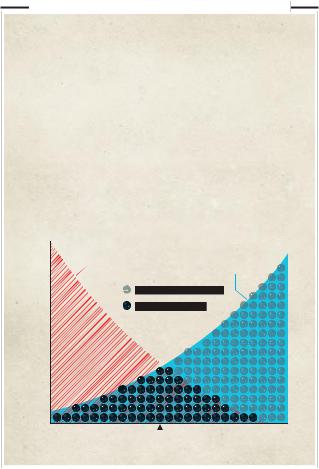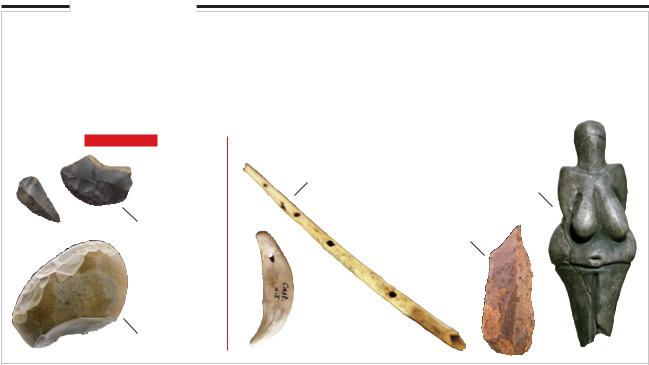

TechnoFiles by David Pogue
David Pogue is the personal-technology columnist for the New York Times and an Emmy Award–winning correspondent for CBS News.
The Perils of Copy Protection
Tech companies handcuff our files to protect against digital pirates. The strategy isn’t just annoying for customers—it could be hurting sales
Years ago Saturday Night Live featured a hilarious sketch—a talk show called Ruining It for Everyone. The guests were all people whose stupid, destructive acts wound up changing society forever, adding bureaucracy and rules and making life less convenient for the rest of the world.
There was the guy who poisoned a Tylenol bottle, which led to the new world of tamper-proof seals; the woman who first drove off without paying for self-serve gas, triggering the era of having to prepay; and the guy who first befouled a restaurant bathroom, so now only paying customers are allowed to use them.
They should have had the guy who first pirated music. He, after all, launched the modern age of copy protection—our current crazy world where the honest are penalized and the pirates go free.
When the iTunes store opened, every song was copy-protect- ed. You could play the tracks on a computer or an iPod—but not on your cell phone or on any non-Apple music player.
Internet movies are also ridiculously protected. For example, once you rent a movie, you generally have 24 hours to finish watching it. That’s idiotic. What if it gets to be bedtime, and you want to finish the movie tomorrow night? Don’t these movie executives have children? And why 24 hours? Does it take 25 for a hacker to remove the copy protection?
No, of course not. Nonpaying movie buffs don’t have to strip off the copy protection; they never even see it. They use BitTorrent and get their movies for free.
Similarly, the proprietary e-book copy-protection schemes of
Radar technology designed to detect what’s in front of you, behind you and in your blind spots.* 
*Optional adaptive cruise control and collision warning with brake support and BLIS® (Blind Spot Information System) with cross-traffic alert. Availability varies by vehicle.
36 Scientific American, August 2011
© 2011 Scientific American

Amazon, Sony and Barnes & Noble ensure that each company’s |
|
|
|
|
|
titles can’t be read on rivals’ machines. It’s an attempt to stop |
|
|
|
|
|
book pirates, of course—but those people are off happily down- |
|
|
|
|
|
loading their books from free piracy sites. |
|
|
|
|
|
The biggest problem is that all of this inconvenience is based |
|
|
|
|
|
on a gut feeling. In a world without copy protection, would the |
|
|
|
|
|
e-book, music and movie industries collapse? Instinct—or at |
A recent satirical children’s book showed how piracy can ac- |
||||
least media company executives’ instinct—certainly says so. But |
tually boost sales. Months before the book came out, a PDF of |
||||
without some kind of test, nobody can say for sure. |
|
the story was leaked online and promptly went viral. Yet the |
|||
Actually there have been such tests—at least three of them. |
leak generated so much interest in the book that eager readers |
||||
I make most of my income writing computer books. To my |
soon pushed it to the top of Amazon’s best-seller list. |
||||
great distress, I discovered that they are widely available online |
Even the music industry came to realize that copy protection |
||||
as PDF files. But when I griped on my blog, my readers chal- |
makes life miserable for the honest customers while doing abso- |
||||
lenged the assumption that I was losing sales. |
|
lutely nothing to stop the pirates. Today virtually no music files |
|||
“First of all,” they said, “you’re counting a lot of people who |
sold online are copy-protected. |
||||
never would have bought the book in the first place. Those don’t |
Sure, the online stores still lose sales to music pirates—but |
||||
represent lost sales. And you’re not counting the people who like |
not measurably more than before. Meanwhile music copy pro- |
||||
the PDF so much, they go buy the print edition or discover from |
tection is no longer inconveniencing everybody else. |
||||
the PDF sample that they like your writing.” One reader chal- |
Until that lesson sinks in with the other industries—e-books, |
||||
lenged me to a test: make one book available both on paper and as |
movies, television, computer software, maybe even the Trans- |
||||
an unprotected PDF file. Report the effect of sales after one year. |
portation Security Administration—I hope Saturday Night Live |
||||
I did that. The results were clear: Piracy was ram- |
|
|
someday remakes that talk-show skit. Can’t you just |
||
pant. The book was everywhere online. But weirdly, |
|
see the list of modern Ruining It for Everyone guests? |
|||
THE SIX (LEGAL) WAYS |
|||||
my readers were also proved right. Sales of the print- |
TO GET MUSIC ONLINE |
The guy who wrote the first computer virus, the very |
|||
ed edition did not suffer; in fact, they rose slightly |
ScientificAmerican.com/ |
first spammer, the first person who tried to sneak a |
|||
year over year. |
aug2011/pogue |
bomb through airport security in his shoes.... |
|
|
|
|
|
||||
|
|
|
|
||
|
|
|
|
|
|
From a company with vision. Literally.
August 2011, ScientificAmerican.com 37
© 2011 Scientific American

DOESC M L GY THE
MULTIVERSE
Proof of parallel universes radically different from our own may still lie beyond the domain of science
By George F. R. Ellis
I |
n the past decade an extraordinary claim has captivated cosmologists: that the expanding |
|
|
||
|
universe we see around us is not the only one; that billions of other universes are out there, |
|
|
too. There is not one universe—there is a multiverse. In Scientific American articles and |
|
|
books such as Brian Greene’s latest, The Hidden Reality, leading scientists have spoken of a |
|
|
super-Copernican revolution. In this view, not only is our planet one among many, but even |
|
our entire universe is |
on the cosmic scale of things. It is just one of countless uni- |
|
verses, each doing its own thing. |
|
|
The word “multiverse” has different meanings. Astronomers are able to see out to a distance of about 42 billion light-years, our cosmic visual horizon. We have no reason to suspect the universe stops there. Beyond it could be many—even infinitely many—domains much like the one we see. Each has a different initial distribution of matter, but the same laws of physics operate in all. Nearly all cosmologists today (including me) accept this type of multiverse, which Max Tegmark calls “level 1.” Yet some go further. They suggest completely different kinds of universes, with different physics, different histories, maybe different numbers of spatial dimensions. Most will be sterile, although some will be teeming with life. A chief proponent of this “level 2”
38 Scientific American, August 2011 |
Photograph by Levi Brown |
© 2011 Scientific American

George F. R. Ellis is a cosmologist and emeritus mathematics professor at the University of Cape Town in South Africa. He is one of the world’s leading experts on Einstein’s general theory of relativity and co-author, with Stephen Hawking, of the seminal book The Large Scale Structure of Space-Time (Cambridge University Press, 1975).
IN BRIEF
The notion of parallel universes leapt out of the pages of fiction intoscientificjournalsinthe1990s. Many scientists claim that megamillions of other universes, each withitsownlawsofphysics,lieout there, beyond our visual horizon. Theyarecollectivelyknownasthe multiverse.
The trouble isthatnopossibleastronomical observations can ever see those other universes.The arguments are indirect at best. And even if the multiverse exists, it leaves the deep mysteries of natureunexplained.
August 2011, ScientificAmerican.com 39
© 2011 Scientific American

THE PERILS OF EXTRAPOLATION
What Lies Beyond?
When astronomers peer into the universe, they see out to a distance of about 42 billion lightyears‚ our cosmic horizon, which represents how far light has been able to travel since the big bang (as well as how much the universe has expanded in size since then). Assuming that space does not just stop there and may well be infinitely big,cosmologists make educated guesses as to what the rest of it looks like.
Level 1 Multiverse: Plausible Themoststraightforward assumptionisthatourvolumeofspaceisarepresentative sampleofthewhole.Distantalienbeingsseedifferent volumes‚butalloftheselookbasicallyalike,apartfrom randomvariationsinthedistributionofmatter.Togetherthese regions,seenandunseen,formabasictypeofmultiverse.
Level 2 Multiverse: Questionable Manycosmologists gofurtherandspeculatethat,sufficientlyfaraway,things lookquitedifferentfromwhatwesee.Ourenvironsmay beoneofmanybubblesfloatinginanotherwiseempty background.Thelawsofphysicswoulddifferfrombubble tobubble,leadingtoanalmostinconceivablevarietyof
outcomes.Thoseotherbubblesmaybeimpossibletoobserve eveninprinciple.Theauthorandotherskepticsfeeldubious aboutthistypeofmultiverse.
multiverse is Alexander Vilenkin, who paints a dramatic picture of an infinite set of universes with an infinite number of galaxies, an infinite number of planets and an infinite number of people with your name who are reading this article.
Similar claims have been made since antiquity by many cultures. What is new is the assertion that the multiverse is a scientific theory, with all that implies about being mathematically rigorous and experimentally testable. I am skeptical about this claim. I do not believe the existence of those other universes has been proved—or ever could be. Proponents of the multiverse, as well as greatly enlarging our conception of physical reality, are implicitly redefining what is meant by “science.”
OVER THE HORIZON
those who subscribe to a broad conception of the multiverse have various proposals as to how such a proliferation of universes might arise and where they would all reside. They might be sitting in regions of space far beyond our own, as envisaged by the chaotic inflation model of Alan H. Guth, Andrei Linde and others [see “The Self-Reproducing Inflationary Universe,” by Andrei Linde; Scientific American, November 1994]. They might exist at different epochs of time, as proposed in the cyclic universe model of Paul J. Steinhardt and Neil Turok [see “The Myth of the Beginning of Time,” by Gabriele Veneziano; Scientific American, May 2004]. They might exist in the same space we do but in a different branch of the quantum wave function, as advocated by David Deutsch [see “The Quantum Physics of Time Travel,” by David Deutsch and Michael Lockwood; Scientific American, March 1994]. They might not have a location, being completely disconnected from our spacetime, as suggested by
Us
42 billion light-years
Observable Universe
Tegmark and Dennis Sciama [see “Parallel Universes,” by Max Tegmark; Scientific American, May 2003].
Of these options, the most widely accepted is that of chaotic inflation, and I will concentrate on it; however, most of my remarks apply to all the other proposals as well. The idea is that space at large is an eternally expanding void, within which quantum effects continually spawn new universes like a child blowing bubbles. The concept of inflation goes back to the 1980s, and physicists have elaborated on it based on their most comprehensive theory of nature: string theory. String theory allows bubbles to look very different from one another. In effect, each begins life not only with a random distribution of matter but also with random types of matter. Our universe contains particles such as electrons and quarks interacting through forces such as electromagnetism; other universes may have very different types of particles and forces—which is to say, different local laws of physics. The full set of allowed local laws is known as the landscape. In some interpretations of string theory, the landscape is immense, ensuring a tremendous diversity of universes.
Many physicists who talk about the multiverse, especially advocates of the string landscape, do not care much about parallel universes per se. For them, objections to the multiverse as a concept are unimportant. Their theories live or die based on internal consistency and, one hopes, eventual laboratory testing. They assume a multiverse context for their theories without worrying about how it comes to be—which is what concerns cosmologists.
For a cosmologist, the basic problem with all multiverse proposals is the presence of a cosmic visual horizon. The horizon is the limit to how far away we can see, because signals traveling toward us at the speed of light (which is finite) have not had time
40 Scientific American, August 2011 |
Illustrations by Chad Hagen |
© 2011 Scientific American

Us |
Us |
Level 1 Multiverse
since the beginning of the universe to reach us from farther out. All the parallel universes lie outside our horizon and remain beyond our capacity to see, now or ever, no matter how technology evolves. In fact, they are too far away to have had any influence on our universe whatsoever. That is why none of the claims made by multiverse enthusiasts can be directly substantiated.
The proponents are telling us we can state in broad terms what happens 1,000 times as far as our cosmic horizon, 10100 times, 101,000,000 times, an infinity—all from data we obtain within the horizon. It is an extrapolation of an extraordinary kind. Maybe the universe closes up on a very large scale, and there is no infinity out there. Maybe all the matter in the universe ends somewhere, and there is empty space forever after. Maybe space and time come to an end at a singularity that bounds the universe. We just do not know what actually happens, for we have no information about these regions and never will.
SEVEN QUESTIONABLE ARGUMENTS
most multiverse proponents are careful scientists who are quite aware of this problem but think we can still make educated guesses about what is going on out there. Their arguments fall into seven broad types, each of which runs into trouble.
Space has no end. Few dispute that space extends beyond our cosmic horizon and that many other domains lie beyond what we see. If this limited type of multiverse exists, we can extrapolate what we see to domains beyond the horizon, with more and more uncertainty as regards the farther-out regions. It is then easy to imagine more elaborate types of variation, including alternative physics occurring out where we cannot see. But the trouble with this type of extrapolation, from the known to the un-
Level 2 Multiverse
known, is that no one can prove you wrong. How can scientists decide whether their picture of an unobservable region of spacetime is a reasonable or an unreasonable extrapolation of what we see? Might other universes have different initial distributions of matter, or might they also have different values of fundamental physical constants, such as those that set the strength of nuclear forces? You could get either, depending on what you assume.
Known physics predicts other domains. Proposed unified theories predict entities such as scalar fields, a hypothesized relative of other space-filling fields such as the magnetic field. Such fields should drive cosmic inflation and create universes ad infinitum. These theories are well grounded theoretically, but the nature of the hypothesized fields is unknown, and experimentalists have yet to demonstrate their existence, let alone measure their supposed properties. Crucially, physicists have not substantiated that the dynamics of these fields would cause different laws of physics to operate in different bubble universes.
The theory that predicts an infinity of universes passes a key observational test. The cosmic microwave background radiation reveals what the universe looked like at the end of its hot early expansion era. Patterns in it suggest that our universe really did undergo a period of inflation. But not all types of inflation go on forever and create an infinite number of bubble universes. Observations do not single out the required type of inflation from other types. Some cosmologists such as Steinhardt even argue that eternal inflation would have led to different patterns in the background radiation than we see [see “The Inflation Debate,” by Paul J. Steinhardt; Scientific American, April]. Linde and others disagree. Who is right? It all depends on what you assume about the physics of the inflationary field.
August 2011, ScientificAmerican.com 41
© 2011 Scientific American

Fundamental constants are finely tuned for life. A remarkable fact about our universe is that physical constants have just the right values needed to allow for complex structures, including living things. Steven Weinberg, Martin Rees, Leonard Susskind and others contend that an exotic multiverse provides a tidy explanation for this apparent coincidence: if all possible values occur in a large enough collection of universes, then viable ones for life will surely be found somewhere. This reasoning has been applied, in particular, to explaining the density of the dark energy that is speeding up the expansion of the universe today. I agree that the multiverse is a possible valid explanation for the value of this density; arguably, it is the only scientifically based option we have right now. But we have no hope of testing it observationally. Additionally, most analyses of the issue assume the basic equations of physics are the same everywhere, with only the constants differing—but if one takes the multiverse seriously, this need not be so [see “Looking for Life in the Multiverse,” by Alejandro Jenkins and Gilad Perez; Scientific American, January 2010].
Fundamental constants match multiverse predictions.
This argument refines the previous one by suggesting that the universe is no more finely tuned for life than it strictly needs to be. Proponents have assessed the probabilities of various values of the dark energy density. The higher the value is, the more probable it is, but the more hostile the universe would be to life. The value we observe should be just on the borderline of uninhabitability, and it does appear to be so [see illustration at right]. Where the argument stumbles is that we cannot apply a probability argument if there is no multiverse to apply the concept of probability to. This argument thus assumes the desired outcome before it starts; it simply is not applicable if there is only one physically existing universe. Probability is a probe of the consistency of the multiverse proposal, not a proof of its existence.
String theory predicts a diversity of universes. String theory has moved from being a theory that explains everything to a theory where almost anything is possible. In its current form, it predicts that many essential properties of our universe are pure happenstance. If the universe is one of a kind, those properties seem inexplicable. How can we understand, for example, the fact that physics has precisely those highly constrained properties that allow life to exist? If the universe is one of many, those properties make perfect sense. Nothing singled them out; they are simply the ones that arose in our region of space. Had we lived elsewhere, we would have observed different properties, if we could indeed exist there (life would be impossible in most places). But string theory is not a tried-and-tested theory; it is not even a complete theory. If we had proof that string theory is correct, its theoretical predictions could be a legitimate, experimentally based argument for a multiverse. We do not have such proof.
All that can happen, happens. In seeking to explain why nature obeys certain laws and not others, some physicists and philosophers have speculated that nature never made any such choice: all conceivable laws apply somewhere. The idea is inspired in part by quantum mechanics, which, as Murray GellMann memorably put it, holds that everything not forbidden is compulsory. A particle takes all the paths it can, and what we see is the weighted average of all those possibilities. Perhaps the same is true of the entire universe, implying a multiverse. But astronomers have not the slightest chance of observing this multiplicity of possibilities. Indeed, we cannot even know what the
DARK ENERGY AND THE MULTIVERSE
Does the Glove Fit?
As evidence for a multiverse, proponents often cite the density of the dark energy that dominates our universe. The process of eternal inflation endows each universe in a multiverse with a random density of dark energy.Relatively few universes have zero or a low value; most have higher values (blue area). But too much dark energy tears apart the complex structures needed to sustain life (red area). So most habitable universes should have a middling density of dark energy (peak of overlap region)—and, lo and behold, our universe does. Multiverse skeptics, though, say this reasoning is circular: it holds only if you assume the multiverse to begin with.It is a consistency test,not a proof.
High |
Odds that life could survive |
Odds that a universe could form
Probability
Low
Low |
Observed |
High |
|
Density of Dark Energy |
|
possibilities are. We can only make sense of this proposal in the face of some unverifiable organizing principle or framework that decides what is allowed and what is not—for example, that all possible mathematical structures must be realized in some physical domain (as proposed by Tegmark). But we have no idea what kinds of existence this principle entails, apart from the fact that it must, of necessity, include the world we see around us. And we have no way whatsoever to verify the existence or nature of any such organizing principle. It is in some ways an attractive proposition, but its proposed application to reality is pure speculation.
ABSENCE OF EVIDENCE
although the theoretical arguments fall short, cosmologists have also suggested various empirical tests for parallel universes. The cosmic microwave background radiation might bear some traces of other bubble universes if, for example, our universe has ever collided with another bubble of the kind implied by the chaotic inflation scenario. The background radiation might also contain remnants of universes that existed before the big bang in an endless cycle of universes. These are indeed ways one might get real evidence of other universes. Some cosmologists have even claimed to see such remnants. The observational claims are strongly disputed, however, and many of the hypothetically possible multiverses would not lead to such evidence. So observers can test only some specific classes of multiverse models in this way.
A second observational test is to look for variations in one or
42 Scientific American, August 2011 |
Graphic by Jen Christiansen |
© 2011 Scientific American

more fundamental constants, which would corroborate the premise that the laws of physics are not so immutable after all. Some astronomers claim to have found such variations [see “Inconstant Constants,” by John D. Barrow and John K. Webb; Scientific American, June 2005]. Most, though, consider the evidence dubious.
A third test is to measure the shape of the observable universe: Is it spherical (positively curved), hyperbolic (negatively curved) or “flat” (uncurved)? Multiverse scenarios generally predict that the universe is not spherical, because a sphere closes up on itself, allowing for only a finite volume. Unfortunately, this test is not a clean one. The universe beyond our horizon could have a different shape from that in the observed part; what is more, not all multiverse theories rule out a spherical geometry.
A better test is the topology of the universe: Does it wrap around like a doughnut or pretzel? If so, it would be finite in size, which would definitely disprove most versions of inflation and, in particular, multiverse scenarios based on chaotic inflation. Such a shape would produce recurring patterns in the sky, such as giant circles in the cosmic microwave background radiation [see “Is Space Finite?” by Jean-Pierre Luminet, Glenn D. Starkman and Jeffrey R. Weeks; Scientific American, April 1999]. Observers have looked for and failed to find any such patterns. But this null result cannot be taken as a point in favor of the multiverse.
Finally, physicists might hope to prove or disprove some of the theories that predict a multiverse. They might find observational evidence against chaotic versions of inflation or discover a mathematical or empirical inconsistency that forces them to abandon the landscape of string theory. That scenario would undermine much of the motivation for supporting the multiverse idea, although it would not rule the concept out altogether.
TOO MUCH WIGGLE ROOM
all in all, the case for the multiverse is inconclusive. The basic reason is the extreme flexibility of the proposal: it is more a concept than a well-defined theory. Most proposals involve a patchwork of different ideas rather than a coherent whole. The basic mechanism for eternal inflation does not itself cause physics to be different in each domain in a multiverse; for that, it needs to be coupled to another speculative theory. Although they can be fitted together, there is nothing inevitable about it.
The key step in justifying a multiverse is extrapolation from the known to the unknown, from the testable to the untestable. You get different answers depending on what you choose to extrapolate. Because theories involving a multiverse can explain almost anything whatsoever, any observation can be accommodated by some multiverse variant. The various “proofs,” in effect, propose that we should accept a theoretical explanation instead of insisting on observational testing. But such testing has, up until now, been the central requirement of the scientific endeavor, and we abandon it at our peril. If we weaken the requirement of solid data, we weaken the core reason for the success of science over the past centuries.
Now, it is true that a satisfactory unifying explanation of some range of phenomena carries greater weight than a hodgepodge of separate arguments for the same phenomena. If the unifying explanation assumes the existence of unobservable entities such as parallel universes, we might well feel compelled to accept those entities. But a key issue here is how many unverifiable entities are needed. Specifically, are we hypothesizing more
or fewer entities than the number of phenomena to be explained? In the case of the multiverse, we are supposing the existence of a huge number—perhaps even an infinity—of unobservable entities to explain just one existing universe. It hardly fits 14th-century English philosopher William of Ockham’s stricture that “entities must not be multiplied beyond necessity.”
Proponents of the multiverse make one final argument: that there are no good alternatives. As distasteful as scientists might find the proliferation of parallel worlds, if it is the best explanation, we would be driven to accept it; conversely, if we are to give up the multiverse, we need a viable alternative. This exploration of alternatives depends on what kind of explanation we are prepared to accept. Physicists’ hope has always been that the laws of nature are inevitable—that things are the way they are because there is no other way they might have been—but we have been unable to show this is true. Other options exist, too. The universe might be pure happenstance—it just turned out that way. Or things might in some sense be meant to be the way they are—purpose or intent somehow underlies existence. Science cannot determine which is the case, because these are metaphysical issues.
Scientists proposed the multiverse as a way of resolving deep issues about the nature of existence, but the proposal leaves the ultimate issues unresolved. All the same issues that arise in relation to the universe arise again in relation to the multiverse. If the multiverse exists, did it come into existence through necessity, chance or purpose? That is a metaphysical question that no physical theory can answer for either the universe or the multiverse.
To make progress, we need to keep to the idea that empirical testing is the core of science. We need some kind of causal contact with whatever entities we propose; otherwise, there are no limits. The link can be a bit indirect. If an entity is unobservable but absolutely essential for properties of other entities that are indeed verified, it can be taken as verified. But then the onus of proving it is absolutely essential to the web of explanation. The challenge I pose to multiverse proponents is: Can you prove that unseeable parallel universes are vital to explain the world we do see? And is the link essential and inescapable?
As skeptical as I am, I think the contemplation of the multiverse is an excellent opportunity to reflect on the nature of science and on the ultimate nature of existence: why we are here. It leads to new and interesting insights and so is a productive research program. In looking at this concept, we need an open mind, though not too open. It is a delicate path to tread. Parallel universes may or may not exist; the case is unproved. We are going to have to live with that uncertainty. Nothing is wrong with scientifically based philosophical speculation, which is what multiverse proposals are. But we should name it for what it is. 
MORE TO EXPLORE
Issues in the Philosophy of Cosmology. GeorgeF.R.EllisinPhilosophy of Physics. Editedby JeremyButterfieldandJohnEarman.Elsevier,2006.http://arxiv.org/abs/astro-ph/0602280 Universe or Multiverse? EditedbyBernardCarr.CambridgeUniversityPress,2009.
The Hidden Reality: Parallel Universes and the Deep Laws of the Cosmos. BrianGreene. Knopf,2011.
Higher Speculations: Grand Theories and Failed Revolutions in Physics and Cosmology.
HelgeKragh.OxfordUniversityPress,2011.
SCIENTIFIC AMERICAN ONLINE
Multiverse:Yayornay?Readthedebateandcastyourvoteat
ScientificAmerican.com/aug11/multiverse
August 2011, ScientificAmerican.com 43
© 2011 Scientific American

© 2011 Scientific American

Rachel Caspari is a professor of anthropology at Central Michigan University. Her research focuses on Neandertals, the origin of modern humans and the evolution of longevity.
H U M A N O R I G I N S
the evolution of grandparents
Senior citizens may have been the secret of our species’ success
By Rachel Caspari
IN BRIEF
People today typically live long enough to become |
those of the australopithecines and the Neandertals. |
a driving force for the explosion of new tool types and |
grandparents, but this was not always the case. |
Theyfirstbecamecommonaround30,000yearsago, |
art forms that occurred in Europe at around the same |
Recent analyses of fossil teeth indicate that grand- |
as evidenced by remains of early modern Europeans. |
time. It also may explain how modern humans out- |
parents were rare in ancient populations, such as |
This surge in the number of seniors may have been |
competed archaic groups such as the Neandertals. |
Illustration by Viktor Deak |
|
August 2011, ScientificAmerican.com 45 |
© 2011 Scientific American
During the summer of 1963, when i was six years old, my family traveled from our home in Philadelphia to Los Angeles to visit my maternal relatives. I already knew my grandmother well: she helped my mother care for my twin brothers, who were only 18 months my junior, and me. When she was not with us, my grandmother lived with her mother, whom I met that summer for the first time. I come from a long-lived family. My grandmother was born in 1895, and her mother in the 1860s; both lived almost 100
years. We stayed with the two matriarchs for several weeks. Through their stories, I learned about my roots and where I belonged in a social network spanning four generations. Their reminiscences personally connected me to life at the end of the Civil War and the Reconstruction era and to the challenges my ancestors faced and the ways they persevered.
My story is not unique. Elders play critical roles in human societies around the globe, conveying wisdom and providing social and economic support for the families of their children and larger kin groups. In our modern era, people routinely live long enough to become grandparents. But this was not always the case. When did grandparents become prevalent, and how did their ubiquity affect human evolution?
Research my colleagues and I have been conducting indicates that grandparent-aged individuals became common relatively recently in human prehistory and that this change came at about the same time as cultural shifts toward distinctly modern behaviors—including a dependence on sophisticated sym- bol-based communication of the kind that underpins art and language. These findings suggest that living to an older age had profound effects on the population sizes, social interactions and genetics of early modern human groups and may explain why they were more successful than archaic humans, such as the Neandertals.
LIVE FAST, DIE YOUNG
the first step in figuring out when grandparents became a fixture in society is assessing the typical age breakdown of past populations—what percent were children, adults of childbearing age and parents of those younger adults? Reconstructing the demography of ancient populations is tricky business, however. For one thing, whole populations are never preserved in the fossil record. Rather paleontologists tend to recover fragments of individuals. For another, early humans did not necessarily mature at the same rate as modern humans. In fact, maturation rates differ even among contemporary human populations. But a handful of sites have yielded high enough numbers of human fossils in the same layers of sediment that scientists can confidently assess the age at death of the remains—which is key to understanding the makeup of a prehistoric group.
A rock-shelter located in the town of Krapina in Croatia,
about 40 kilometers northwest of the city of Zagreb, is one such site. More than a century ago Croatian paleontologist Dragutin Gorjanovic´-Kramberger excavated and described the fragmentary remains of perhaps as many as 70 Neandertal individuals there, most of which came from a layer dated to about 130,000 years ago. The large number of fossils found close to one another, the apparently rapid accumulation of the sediments at the site and the fact that some of the remains share distinctive, genetically determined features all indicate that the Krapina bones approximate the remains of a single population of Neandertals. As often happens in the fossil record, the best-preserved remains at Krapina are teeth because the high mineral content of teeth protects them from degradation. Fortunately, teeth are also one of the best skeletal elements for determining age at death, which is achieved by analyzing surface wear and age-re- lated changes in their internal structure.
In 1979, before I began my research into the evolution of grandparents, Milford H. Wolpoff of the University of Michigan at Ann Arbor published a paper, based on dental remains, that assessed how old the Krapina Neandertals were when they died. Molar teeth erupt sequentially. Using one of the fastest eruption schedules observed in modern-day humans as a guide, Wolpoff estimated that the first, second and third molars of Neandertals erupted at ages that rounded to six, 12 and 15, respectively. Wear from chewing accumulates at a steady pace over an individual’s lifetime, so when the second molar emerges, the first already has six years of wear on it, and when the third emerges, the second has three years of wear on it.
Working backward, one can infer, for instance, that a first molar with 15 years of wear on it belonged to a 21-year-old Neandertal, a second molar with 15 years of wear on it belonged to a 27-year-old and a third molar with 15 years of wear on it belonged to a 30-year-old. (These estimates have an uncertainty of plus or minus one year.) This wear-based seriation method for determining age at death, adapted from a technique developed
46 Scientific American, August 2011
© 2011 Scientific American

SOURCE: “OLDER AGE BECOMES COMMON LATE IN HUMAN EVOLUTION,” BY RACHEL CASPARI AND SANG-HEE LEE, IN PNAS, VOL. 101, NO. 30; JULY 27, 2004
by dental researcher A.E.W. Miles in 1963, |
|
|
FINDING S |
|
|
|
||||||
works best on samples with large numbers of |
|
Growing Older |
|
|
||||||||
juveniles, which Krapina has in abundance. |
|
|
|
|||||||||
The method loses accuracy when applied to |
|
|
|
|||||||||
|
|
|
|
|
|
|
|
|
|
|
|
|
the teeth of elderly individuals, whose tooth |
Analyses of the fossilized teeth of hundreds of individuals spanning three |
|
|
|||||||||
crowns can be too worn to evaluate reliably |
million years indicate that living long enough to reach grandparenthood be- |
|||||||||||
and in some cases may even be totally eroded. |
came common relatively late in human evolution. The author and her col- |
|||||||||||
Wolpoff’s work indicated that the Krapina |
league assessed the proportion of older (grandparent-aged) adults relative to |
|||||||||||
Neandertals died young. In 2005, a few years |
younger adults in four groups of human ancestors—australopithecines, early |
|||||||||||
after I began researching the evolution of lon- |
members of the genus Homo, Neandertals and early modern Europeans—and |
|||||||||||
gevity, I decided to take another look at this |
found that the ratio increased only modestly over the course of human evolu- |
|||||||||||
sample using a novel approach. I wanted to |
tion until around 30,000 years ago, when it skyrocketed. |
|
|
|||||||||
make sure that we were not missing older indi- |
|
|
|
|
|
|
|
|
|
|
|
|
viduals as a result of the inherent limitations |
|
|
Time Period |
|
|
|||||||
of wear-based seriation. Working with Jakov |
|
|
3 million years ago |
Today |
||||||||
Radovciˇc´ of the Croatian Natural History Mu- |
Australopithecine |
|
|
|
|
|
|
|
|
|
||
|
|
|
|
|
|
|
|
|
||||
seum in Zagreb, Steven A. Goldstein, Jeffrey A. |
|
|
|
|
|
|
|
|
|
|||
|
|
|
|
|
|
|
|
|
||||
Meganck and Dana L. Begun, all at Michigan, |
|
|
|
Young |
Old |
|
||||||
and undergraduate students from Central |
|
|
|
|
|
|
|
|
|
|
|
|
|
|
|
|
|
|
|
|
|
|
|
|
|
Michigan University, I developed a new non |
|
|
|
|
|
|
|
|
|
|
|
|
destructive method—using high-resolution |
|
|
|
|
|
|
|
|
|
|
|
|
three-dimensional microcomputed tomogra- |
|
|
|
|
|
|
|
|
|
|
|
|
|
Early Homo |
|
|
|
|
|
|
|
|
|
||
phy (µCT)—to reassess how old the Krapina in- |
|
|
|
|
|
|
|
|
|
|
||
|
|
|
|
|
|
|
|
|
|
|
|
|
dividuals were when they died. Specifically, we |
|
|
|
|
|
|
|
|
|
|
|
|
looked at the degree of development of a type |
|
|
|
|
|
|
|
|
|
|
|
|
of tissue within the tooth called secondary den- |
|
|
|
|
|
|
|
|
|
|
|
|
tin; the volume of secondary dentin increases |
|
|
|
|
|
|
|
|
|
|
|
|
|
|
|
|
|
|
|
|
|
|
|
|
|
|
Neandertal |
|
|
|
|
|
|
|
|
|
||
with age and provides a way to assess how old |
|
|
|
|
|
|
|
|
|
|||
|
|
|
|
|
|
|
|
|
||||
|
|
|
|
|
|
|
|
|
|
|
|
|
an individual was at death when the tooth |
|
|
|
|
|
|
|
|
|
|
|
|
crown is too worn to be a good indicator. |
|
|
|
|
|
|
|
|
|
|
|
|
|
|
|
|
|
|
|
|
|
|
|
|
|
Our initial findings, supplemented with |
|
|
|
|
|
|
|
|
|
|
|
|
scans provided by the Max Planck Institute for |
|
|
|
|
|
|
|
|
|
|
|
|
|
|
|
|
|
|
|
|
|
|
|
|
|
Evolutionary Anthropology in Leipzig, corrob- |
Early modern European |
|
|
|
|
|
|
|
|
|
||
|
|
|
|
|
|
|
||||||
orated Wolpoff’s results and validated the |
|
|
|
|
|
|
|
|
|
|
|
|
wear-based seriation method: the Krapina Ne- |
|
|
|
|
|
|
|
|
|
|
|
|
|
|
|
|
|
|
|
|
|
|
|
|
|
andertals had remarkably high mortality rates; |
|
|
|
|
|
|
|
|
|
|
|
|
no one survived past age 30. (This is not to say |
|
|
|
|
|
|
|
|
|
|
|
|
|
|
|
|
|
|
|
|
|
|
|
|
|
that Neandertals across the board never lived |
|
|
|
|
|
|
|
|
|
|
|
|
beyond 30. A few individuals from sites other |
|
|
|
|
|
|
|
|
|
|
|
|
than Krapina were around 40 when they died.) |
|
RISE OF THE GRANDPARENTS |
|
|
||||||||
By today’s standards, the Krapina death pattern is unimagi- |
this new µct approach has the potential to provide a high-reso- |
|||||||||||
nable. After all, for most people age 30 is the prime of life. And |
lution picture of the ages of older individuals in other fossil hu- |
|||||||||||
hunter-gatherers lived beyond 30 in the recent past. Yet the |
man populations. But a few years ago, before we hit on this |
|||||||||||
Krapina Neandertals are not unique among early humans. The |
technique, Sang-Hee Lee of the University of California, River- |
|||||||||||
few other human fossil localities with large numbers of individ- |
side, and I were ready to start looking for evidence of changes |
|||||||||||
uals preserved, such as the approximately 600,000-year-old |
in longevity over the course of human evolution. We turned to |
|||||||||||
Sima de los Huesos site in Atapuerca, Spain, show similar pat- |
the best approach available at the time: wear-based seriation. |
|||||||||||
terns. The Sima de los Huesos people had very high levels of ju- |
We faced a daunting challenge, though. Most human fossils |
|||||||||||
venile and young adult mortality, with no one surviving past 35 |
do not come from sites, such as Krapina, that preserve so many |
|||||||||||
and very few living even that long. It is possible that cata- |
individuals that the remains can be considered reflective of their |
|||||||||||
strophic events or the particular conditions under which the |
larger populations. And the smaller the number of contempora- |
|||||||||||
remains became fossilized somehow selected against the pres- |
neous individuals found at a site, the more difficult it is to reli- |
|||||||||||
ervation of older individuals at these sites. But the broad sur- |
ably estimate how old members were when they died because of |
|||||||||||
veys of the human fossil record—including the material from |
the statistical uncertainties associated with small samples. |
|||||||||||
these unusually rich sites and other sites containing fewer indi- |
But we realized that we could get at the question of when |
|||||||||||
viduals—that my colleagues and I have conducted indicate that |
grandparents started becoming common in another way. In- |
|||||||||||
dying young was the rule, not the exception. To paraphrase |
stead of asking how long individuals lived, we asked how many |
|||||||||||
words attributed to British philosopher Thomas Hobbes, pre- |
of them lived to be old. That is, rather than focusing on absolute |
|||||||||||
historic life really was nasty, brutish and short. |
|
ages, we calculated relative ages and asked what proportion of |
||||||||||
Illustration by Portia Sloan Rollings, Graphic by Jen Christiansen |
|
|
|
August 2011, ScientificAmerican.com 47 |
||||||||
© 2011 Scientific American

adults survived to the age at which one could first become a grandparent. Our objective was to evaluate changes over evolutionary time in the ratio of older to younger adults—the socalled OY ratio. Among primates, including humans up until very recently, the third molar erupts at about the same time that an individual becomes an adult and reaches reproductive age. Based on data from Neandertals and contemporary huntergatherer populations, we inferred that fossil humans got their third molars and had their first child at around age 15. And we considered double that age to mark the beginning of grandpar- enthood—just as some women today can potentially give birth at age 15 and those women can become grandmothers when their own children reach age 15 and reproduce.
For our purposes, then, any archaic individual judged to be 30 years old or more qualified as an older adult—one old enough to have become a grandparent. But the beauty of the OY ratio approach is that regardless of whether maturation occurred at 10, 15 or 20 years, the number of older and younger individuals in a sample would be unaffected because the start of older adulthood would change accordingly. And because we were only looking to place the fossils in these two broad categories, we could include large numbers of smaller fossil samples in our analysis without worrying about uncertainties in absolute ages.
We calculated the OY ratios for four large aggregates of fossil samples totaling 768 individuals spanning a period of three million years. One aggregate comprised later australopithe- cines—those primitive relatives of “Lucy,” who lived in East Africa and South Africa from three million to 1.5 million years ago. Another aggregate consisted of early members of our genus, Homo, from around the globe who lived between two million and 500,000 years ago. The third group was the European Neandertals from 130,000 to 30,000 years ago. And the last consisted of modern Europeans from the early Upper Paleolith-
ic period, who lived between about 30,000 and 20,000 years ago and left behind sophisticated cultural remains.
Although we expected to find increases in longevity over time, we were unprepared for how striking our results would turn out to be. We observed a small trend of increased longevity over time among all samples, but the difference between earlier humans and the modern humans of the Upper Paleolithic was a dramatic fivefold increase in the OY ratio. Thus, for every 10 young adult Neandertals who died between the ages of 15 and 30, there were only four older adults who survived past age 30; in contrast, for every 10 young adults in the European Upper Paleolithic death distribution, there were 20 potential grandparents. Wondering whether the higher numbers of burials at Upper Paleolithic sites might account for the high number of older adults in that sample, we reanalyzed our Upper Paleolithic sample, using only those remains that had not been buried. But we got similar results. The conclusion was inescapable: adult survivorship soared very late in human evolution.
BIOLOGY OR CULTURE?
now that lee and i had established that the number of potential grandparents surged at some point in the evolution of anatomically modern humans, we had another question on our hands: What was it that brought about this change? There were two possibilities. Either longevity was one of the constellations of genetically controlled traits that biologically distinguished anatomically modern humans from their predecessors, or it did not come along with the emergence of modern anatomy and was instead the result of a later shift in behavior. Anatomically modern humans did not burst onto the evolutionary scene making the art and advanced weaponry that define Upper Paleolithic culture. They originated long before those Upper Paleolithic Europeans, more than 100,000 years ago, and for most of that time they and their anatomically
CONSEQUENCE S
Culture Comes of Age
A marked increase in adult survivorship starting around 30,000 years ago in Europe may account for the dramatic cultural shift that ensued there as the comparatively simple technology of the Middle Paleolithic gave way to the sophisticated weapons and art of the Upper Paleolithic. Representative artifacts from both cultural traditions are shown here.
Middle Paleolithic
Flint point (left) and side scraper (right) fromLeMoustier,
France
Stone double-sided scraperfrom
Combe Grenal, France
|
|
Upper Paleolithic |
|
Boneflutefrom |
CeramicVenusfigurinefrom |
||
Hohle Fels, Germany |
Dolni Vestonice, Czech Republic |
||
|
Stoneburinfrom |
||
|
Brassempouy, France |
||
 Wolftoothpendantfrom
Wolftoothpendantfrom
Abri Castanet, France
ARTIFACTS NOT TO SCALE
48 Scientific American, August 2011
|
(wolf tooth); GETTY IMAGES (flute); |
Getty Images (Venus figurine) |
side scraper); |
New York University |
DANITA DELIMONT |
NATURAL HISTORY MUSEUM, LONDON (flint point and |
DAVID L. BRILL (double-sided scraper); RANDALLWHITE |
DIDIER DESCOUENS Museum of Toulouse, France (burin); |
© 2011 Scientific American

archaic contemporaries the Neandertals used the same, simpler Middle Paleolithic technology. (Members of both groups appear to have dabbled in making art and sophisticated weapons before the Upper Paleolithic, but these traditions were ephemeral compared with the ubiquitous and enduring ones that characterize that later period.) Although our study indicated that a large increase in grandparents was unique to anatomically modern humans, it alone could not distinguish between the biological explanation and the cultural one, because the modern humans we looked at were both anatomically and behaviorally modern. Could we trace longevity back to earlier anatomically modern humans who were not yet behaviorally modern?
To address this question, Lee and I analyzed Middle Paleolithic humans from sites in western Asia dating to between about 110,000 and 40,000 years ago. Our sample included both Neandertals and modern humans, all associated with the same comparatively simple artifacts. This approach allowed us to compare the OY ratios of two biologically distinct groups (many scholars consider them to be separate species) who lived in the same region and had the same cultural complexity. We found that the Neandertals and modern humans from western Asia had statistically identical OY ratios, ruling out the possibility that a biological shift accounted for the increase in adult survivorship seen in Upper Paleolithic Europeans. Both western Asian groups had roughly even proportions of older and younger adults, putting their OY ratios between those of the Neandertals and early modern humans from Europe.
Compared with European Neandertals, a much larger proportion of western Asian Neandertals (and modern humans) lived to be grandparents. This is not unexpected—the more temperate environment of western Asia would have been far easier to survive in than the harsh ecological conditions of Ice Age Europe. Yet if the more temperate environment of western Asia accounts for the elevated adult survivorship seen in the Middle Paleolithic populations there, the longevity of Upper Paleolithic Europeans is even more impressive. Despite living in much harsher conditions, the Upper Paleolithic Europeans had an OY ratio more than double that of the Middle Paleolithic modern humans.
SENIOR MOMENTS
we do not know exactly what those Upper Paleolithic Europeans started doing culturally that allowed so many more of them to live to older age. But there can be no doubt that this increased adult survivorship itself had far-reaching effects. As Kristen Hawkes of the University of Utah, Hillard Kaplan of the University of New Mexico and others have shown in their studies of several modern-day hunter-gatherer groups, grandparents routinely contribute economic and social resources to their descendants, increasing both the number of offspring their children can have and the survivorship of their grandchildren. Grandparents also reinforce complex social connections—like my grandmother did in telling stories of ancestors that linked me to other relatives in my generation. Such information is the foundation on which human social organization is built.
Elders transmit other kinds of cultural knowledge, too— from environmental (what kinds of plants are poisonous or where to find water during times of drought, for example) to technological (how to weave a basket or knap a stone knife, per-
haps). Studies led by Pontus Strimling of Stockholm University have shown that repetition is a critical factor in the transmission of the rules and traditions of one’s culture. Multigenerational families have more members to hammer home important lessons. Thus, longevity presumably fostered the intergenerational accumulation and transfer of information that encouraged the formation of intricate kinship systems and other social networks that allow us to help and be helped when the going gets tough.
Increases in longevity would also have translated into increases in population size by adding an age group that was not there in the past and that was still fertile. And large populations are major drivers of new behaviors. In 2009 Adam Powell of University College London and his colleagues published a paper in Science showing that population density figures importantly in the maintenance of cultural complexity. They and many other researchers argue that larger populations promoted the development of extensive trade networks, complex systems of cooperation, and material expressions of individual and group identity (jewelry, body paint, and so on). Viewed in that light, the hallmark features of the Upper Paleolithic—the explosive increase in the use of symbols, for instance, or the incorporation of exotic materials in tool manufacture—look as though they might well have been consequences of swelling population size.
Growing population size would have affected our forebears another way, too: by accelerating the pace of evolution. As John Hawks of the University of Wisconsin–Madison has emphasized, more people mean more mutations and opportunities for advantageous mutations to sweep through populations as their members reproduce. This trend may have had an even more striking effect on recent humans than on Upper Paleolithic ones, compounding the dramatic population growth that accompanied the domestication of plants 10,000 years ago. In their 2009 book The 10,000 Year Explosion, Gregory Cochran and Henry Harpending, both at the University of Utah, describe multiple gene variants—from those influencing skin color to those that determine tolerance of cow milk—that arose and spread swiftly over the past 10,000 years, thanks to the ever larger numbers of breeding individuals.
The relation between adult survivorship and the emergence of sophisticated new cultural traditions, starting with those of the Upper Paleolithic, was almost certainly a positive feedback process. Initially a by-product of some sort of cultural change, longevity became a prerequisite for the unique and complex behaviors that signal modernity. These innovations in turn promoted the importance and survivorship of older adults, which led to the population expansions that had such profound cultural and genetic effects on our predecessors. Older and wiser, indeed. 
M O R E T O E X P L O R E
Older Age Becomes Common Late in Human Evolution. Rachel Caspari and Sang-Hee Lee in Proceedings of the National Academy of Sciences USA, Vol. 101, No.30,pages 10895– 10900;July27,2004.
Is Human Longevity a Consequence of Cultural Change or Modern Human Biology?
Rachel Caspari and Sang-Hee Lee in American Journal of Physical Anthropology, Vol. 129, pages512–517;April2006.
SCIENTIFIC AMERICAN ONLINE
Read about precocious examples of modern human behavior at
ScientificAmerican.com/aug2011/caspari
August 2011, ScientificAmerican.com 49
© 2011 Scientific American
